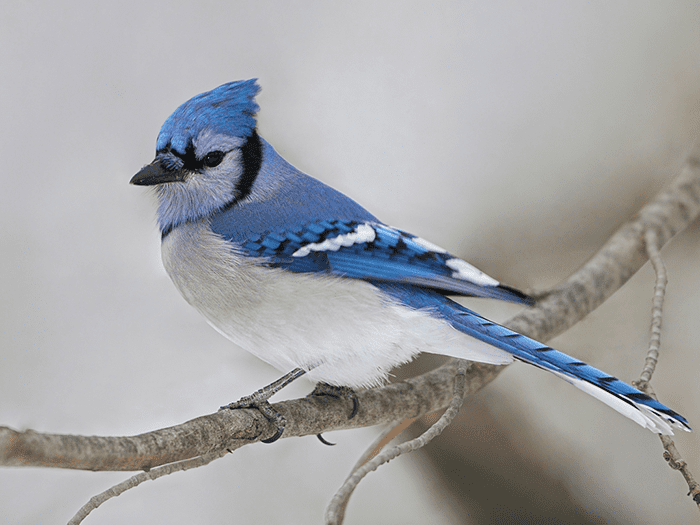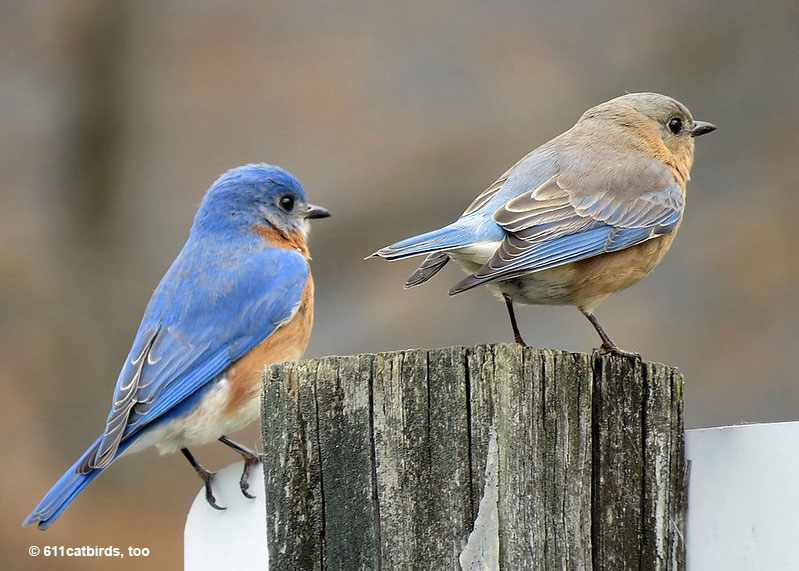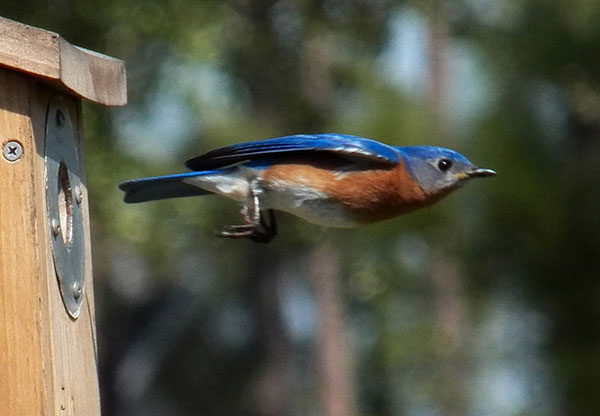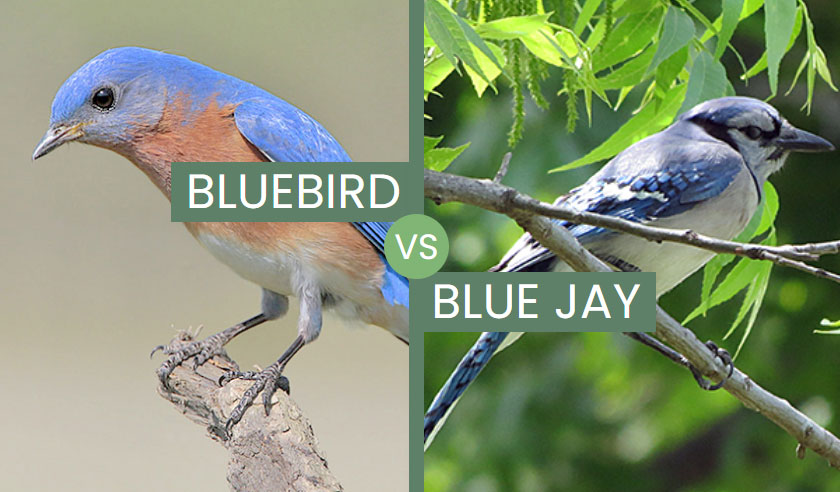Comparing the two – bluebird vs Blue Jay – is common. They are often compared due to their shared coloration of blue feathers.
Despite their similarities, they belong to different families and exhibit distinct physical and behavioral characteristics. While bluebirds are members of the Thrush family and are known for their calm and gentle nature, Blue Jays are part of the Crow family and are renowned for their loud, raucous calls and aggressive behavior.
In this article, we will explore the similarities and differences between bluebirds and Blue Jays, and provide tips on how to easily tell them apart.
On this page
Body & Shape
As their names suggest, both bluebirds and Blue Jays have a lot of blue in their plumage. They also have dark eyes, bills, and feet. However, this is about as far as their similarities go regarding plumage and body shape.
As already mentioned, bluebirds consist of three different species. The Western and Eastern Bluebirds are rather similar with their beautiful deep blue uppersides, rust-colored breasts and flanks, and white lower bellies.
The Mountain Bluebird is cerulean blue overall with darker tones above and lighter tones below. Females of the species are lighter and duller colored, sporting gray instead of blue, duller colors, and have tinges of blue only on their wings and tail.
Blue Jays, on the other hand, do not exhibit sexual dimorphism. That means that both males and females look the same. They are blue above and whitish below, their wings have a white wingbar and black barring, and they have a black “necklace” around their neck. Blue Jays also have a distinct and prominent crest when excited or agitated, which bluebirds lack.
They also differ in body shape. Bluebirds have a rounder, plumper body shape, shorter wings, and tails. Blue Jays have a more streamlined body with a broad chest and long, rounded tails.
Bluebirds have thin, short, and straight bills, while Blue Jays have thicker and stronger bills.
Bluebird vs Blue Jay Size

Blue Jays are bigger in size than bluebirds. Photograph © Jean Weller
When it comes to the size of bluebirds and Blue Jays, there is a noticeable difference between the two. Bluebirds are much smaller than Blue Jays with plumper yet delicate bodies. In contrast, Blue Jays are larger and stockier.
Bluebirds are one of the smaller songbirds found in North America, measuring only 6.3-8.3 inches in length and weighing between 0.8-1.1 ounces across all three bluebird species. On the other hand, Blue Jays are much larger birds, measuring between 9.8-11.8 inches long and weighing between 2.5-3.5 ounces.
Flight
You can recognize whether it’s a bluebird or a Blue Jay by its flight, including by comparing wingspan, wing shape, and flight style. These differences are due to their distinct body shapes, sizes, and habitats.
Blue Jays have a longer wingspan than bluebirds, with a wingspan of 13.4-16.9 inches, while bluebirds have a wingspan of 9.8-14.2 inches.
Despite their differences in wingspan, both birds have overall short and broad wings, allowing them to take off and maneuver between trees and brush quickly.
However, Blue Jays have slightly broader and more rounded wings. This makes sense since they tend to inhabit more forested places and bluebirds more open areas. The broader and more slotted the primary feathers, the better the maneuverability.
They also have significantly different flight styles. Bluebirds often fly low above the ground and are known for their fast and irregular wingbeats. Mountain Bluebirds, in particular, may hover above the ground in air currents as they search for food. In contrast, Blue Jays fly with their bodies and tails level with slow, regular, and easily discernible wing strokes.
Age
Blue Jays and bluebirds have different life expectancies and average lifespans due to various factors, including their size, habitat, predation, and durability. On average, Blue Jays survive longer and reach older ages than bluebirds.
The average possible lifespan for bluebirds is six to ten years. However, realistically, their average lifespan is much lower because most bluebirds survive for only one to two years.
This is due to predation, competition for resources and nesting sites, and harsh weather conditions. Despite this, bluebirds can live up to ten years old in the wild.
In contrast, the average lifespan of a Blue Jay is seven years, but some individuals can live up to 17 years. Blue Jays are bigger, which may give them an advantage over bluebirds in terms of survival. They also have more adaptations, such as the ability to mimic other birds, which increases their chances of survival.
The age difference is also reflected in the age of the oldest wild specimens. The oldest recorded Blue Jay lived to be 26 years and 11 months old, more than twice as old as the oldest bluebird. The oldest bluebird lived to be 10 years and 6 months old.
Bluebird vs Blue Jay Behavior
As with other aspects, bluebirds and Blue Jays have differences in their behavior as well. There are also differences between the three bluebird species, but we will try to keep it short.
Vocalizations

Blue Jay
Often you may hear a bird before you see them, and lucky for you, it is quite easy to differentiate between the vocalizations of Blue Jays, bluebirds, and even the three different bluebird species.
Bluebird songs can be described as fairly low-pitched, hesitant, soft, and pleasant warbling songs that last about 1-3 seconds. Blue Jays, however, can rarely be heard singing, and even then, it is a quiet whispering song of a mix of whirrs, whines, clicks, whistles, and other sounds.
Bluebirds’ calls vary greatly from species to species and differ from Blue Jays’ calls. Western Bluebirds give quavering kew or harsh che-check calls. Eastern Bluebirds give soft and low-pitched chur-lee or similar calls or harsh chit-chit-chit calls.
Mountain Bluebirds give soft and nasal tew or tink calls. Blue Jays, on the other hand, can produce a much wider array of sounds and calls, with the most common one being a loud and unpleasant jeer. They’re also able to mimic hawks and other birds to an extent.
Overall, bluebirds have sweet and soft warbling songs, whereas Blue Jays are much louder and unpleasant to listen to but have a wider array of sounds they can produce.
Sociality
Overall, all bluebirds and Blue Jays are not particularly social with other members of the species, except for Eastern Bluebirds. All of them are very territorial during the breeding season, with the Eastern Bluebirds and Blue Jays living in pairs. Western and Mountain Bluebirds are also territorial, but they may have related helpers that aid with nesting duties.

Bluebirds are often very social. Photograph © 611catbirds, too
During the non-breeding season, all of them are social to a degree. Eastern Bluebirds are very social. Although they are somewhat territorial over their feeding territories, they still gather in big flocks that may contain other birds.
Western Bluebirds are less social and flock together into small groups of related birds, the size of which depends on the available resources. Mountain Bluebirds are the least social of the bluebirds, flocking together with other birds only before, during, and after migration. Blue Jays, however, usually move around in pairs or small family groups. If they migrate, then in large flocks.
Overall, Eastern Bluebirds are the most social, whereas Mountain Bluebirds are the least social of the bunch. Western Bluebirds and Blue Jays stick to living in pairs of family groups and often mate for life.
Blue Jays are also more aggressive and express themselves with both sounds and body language. The higher their crest, the more agitated they are.
Facing intruders
Different bluebird species have different ways of dealing with predators and intruders. When it comes to Western and Eastern Bluebirds, then the guarding and defending duties primarily fall on the male. They will survey the territory, give a warning cry when they spot an intruder, and will attack creatures they deem a threat.
When it comes to Mountain Bluebirds and Blue Jays, then both members of the pair will fiercely defend their nest and offspring.
Blue Jays, due to their larger size, are more active and aggressive in that regard, attacking threats larger than themselves, including humans.
Blue Jays also often mimic hawks and sometimes other species in an attempt to chase others away from their nesting and feeding areas.
Human interactions
Bluebirds and Blue Jays have rather different reactions when it comes to humans. Bluebirds may grow accustomed to humans around them and some of them might even be so engorged in their nesting duties that a human observer might get quite close to them.
Blue Jays are not that friendly towards humans by nature. They are territorial and may deem people as threats. However, they are intelligent and able to remember human faces. If they take an interest in you, they might even follow you around, so be sure to be nice to them.
Bluebird vs Blue Jay Diet
Bluebirds and Blue Jays are both omnivorous, although the specifics vary a bit. Bluebirds are mainly insectivores but resort to eating plant matter, such as small berries, seeds, nuts, and fruit in the winter. Blue Jays prefer to eat plant matter, and it takes up 75% of their diet.

However, due to their size and stronger beak, Blue Jays can eat a bigger variety of foods. Whereas bluebirds usually only limit themselves to small invertebrates such as insects, caterpillars, bees, beetles, and grasshoppers, then Blue Jays also eat small frogs, mice, eggs, nestlings, small reptiles, and carrion. Blue Jays are also able to crack open bigger and tougher nuts.
Their foraging behavior differs as well. Bluebirds generally forage from low perches, surveying the ground for insects and dropping to the ground to catch them. They may hover briefly and just snatch one up instead of landing.
Bluebirds also glean insects from foliage and catch them in mid-air. Mountain Bluebirds often hover over open fields. Blue Jays, on the other hand, don’t hover and often forage on the ground, sometimes in trees and shrubs. They may raid birds’ nests for eggs and nestlings, frighten other birds and steal their food, visit bird feeders, and cache food.
Location
Some parts of the bluebirds’ and Blue Jay’s ranges and habitats overlap, so you may meet them at the same places. However, there are some differences.
The Western and Mountain Bluebird range throughout western North America to central Mexico with Mountain Bluebird’s range extending as far north as Alaska. Eastern Bluebird can be found in eastern North America from southern Canada to central Mexico.
Blue Jay’s range mostly overlaps with that of the Eastern Bluebird and it ranges from southern Canada throughout the eastern and central United States to the border of Mexico.
All of these birds have resident and migratory populations. Eastern and Western Bluebirds are resident to medium-distance migrants and Mountain Bluebirds are short- to medium-distance migrants. Most Blue Jays are resident, with less than 20% of them migrating. Their migration patterns are poorly understood.
However, their habitat types are more diverse. Mountain Bluebirds can be found in the most open habitat types such as grassland- and meadow-type places with few or no trees.
Eastern Bluebirds prefer some trees and sparse ground cover and are most commonly found along pastures and in parks and backyards. Western Bluebirds inhabit semi-open terrain, such as open woodlands and edges of forests with a preference for conifers.
Blue Jays are often seen in conifer or mixed woodlands, edges of forests, and even in well-wooded suburban areas and city parks.
Nest & Eggs
Bluebirds and Blue Jays have distinct differences in their nesting habits. Bluebirds are cavity nesters, whereas Blue Jays build their nests in the crotches of tree trunks or thick outer branches. When it comes to nest building, female bluebirds do all the work, while Blue Jays work together with the male bringing materials and the female building the nest.

Bluebirds love nest boxes too.
Their nests may look similar since they use similar materials, such as twigs, grasses, rootlets, fine grass, animal hair, and feathers. Bluebirds’ nest is usually loose, whereas a Blue Jay’s nest is bulkier and sturdier.
Bluebirds generally have 1-2 broods in a year but Blue Jays only have one. The broods consist of 2-8 eggs. Bluebird eggs are pale blue, bluish-white, or rarely white and are under an inch long and wide. Blue Jays eggs are larger, greenish or buff, sometimes pale blue and blotched with dark markings.
Female bluebirds incubate their eggs for 11-18 days, whereas Blue Jays incubate for 16-18 days. Both members of the Jay pair incubate, although the female does slightly more. After hatching, both members of the pair from all four species take care of the nestlings.
The offspring of Blue Jays stay with their parents for longer, leaving after about two months, while bluebird offspring remain with their parents for approximately two to three weeks after fledging.
Bluebird vs Blue Jay – Frequently Asked Questions
Is there a difference between a bluebird and a Blue Jay?
Bluebirds are from the thrush family whereas Blue Jays are from the corvids family. Bluebirds are smaller and less aggressive than Blue Jays and there are differences in their plumage, size, range and habitat, diet, and behavior.
Do bluebirds and Blue Jays get along?
As a general rule, bluebirds and Blue Jays do not get along. Blue Jays are larger and more aggressive than bluebirds and may even raid their nests for eggs and nestlings.
Conclusions
In conclusion, bluebirds and Blue Jays share some similarities in their blue plumage and diet, partly even in range and habitat, but they also differ significantly in terms of body shape, size, flight, age, and behavior.
Bluebirds have rounder, plumper bodies with short wings and tails, while Blue Jays have a more streamlined bodies with a broad chest and long, rounded tails. Bluebirds are much smaller than Blue Jays, and their flight styles are different, with Blue Jays having a longer wingspan and slower, regular wing strokes. Blue Jays also tend to live longer and have more adaptations, such as the ability to mimic other birds.
Overall, they both have unique characteristics and behaviors that make them stand out from each other.

